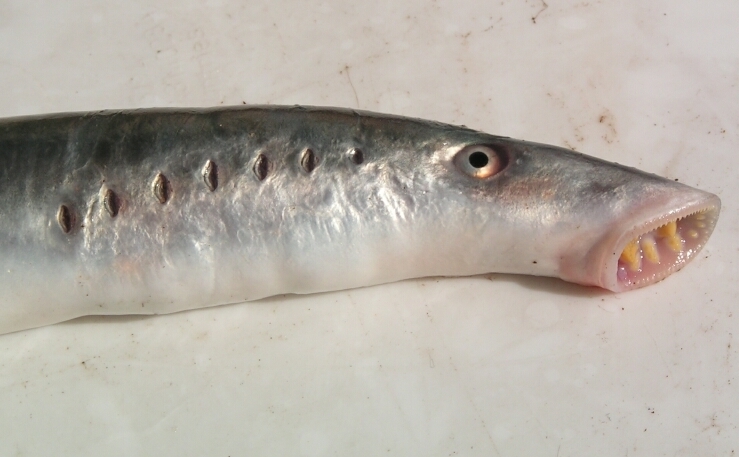
530mya Agnatha
Agnatha are jawless fish. Lampreys and hagfish are in this class. Members of the agnatha class are probably the earliest vertebrates. Scientists have found fossils of agnathan species from the late Cambrian Period that occurred 500 million years ago.
Members of this class of fish don't have paired fins or a stomach. Adults and larvae have a notochord. A notochord is a flexible rod-like cord of cells that provides the main support for the body of an organism during its embryonic stage. A notochord is found in all chordates.
Most agnathans have a skeleton made of cartilage and seven or more paired gill pockets. They have a light sensitive pineal eye. A pineal eye is a third eye in front of the pineal gland. Fertilization of eggs takes place outside the body.
The lamprey looks like an eel, but it has a jawless sucking mouth that it attaches to a fish. It is a parasite and sucks tissue and fluids out of the fish it is attached to. The lamprey's mouth has a ring of cartilage that supports it and rows of horny teeth that it uses to latch on to a fish.
The hagfish is also know as the slime fish. It is eel-like and pinkish in color. It has glands along its sides that produce a thick, sticky slime that it uses as a defense mechanism. The hagfish can also twist its body into knots! It may do this to clean off slime or escape predators. The hagfish may also sneeze to clear its nostrils of slime.
The hagfish is almost completely blind, but it has a good sense of touch and smell. It has a ring of tentacles around its mouth that it uses to feel for food. It has a tongue-like projection that comes out of its jawless mouth. At the end of the projection are tooth-like rasps that close when the "tongue" is pulled back into the hagfish's mouth.
Marine lamprey eels are a common parasite of sport fish and come up the Credit River to spawn. Attempts to control their larvae every few years with toxic lampricide turns the river yellow-green. Many species of hagfish are endangered now that they are being fished for their flesh. They produce copious amounts of a slimy discharge when threatened.
-
Ancestor's Trail Hike
-
Why Is Life On Earth Carbon-Based?
-
Metazoans
-
900MYA we had a common ancestry with Choanoflagellates (non-animal eucaryotes)
-
800mya we had a common ancestry with Sponges
-
780mya we had a common ancestry with Placozoans
-
730mya Ctenophores
-
680mya Cnidarians
-
630mya Flatworms
-
590mya Protosomes
-
570mya Ambulacrarians
-
565mya Tunicates
-
560mya Cephalocordates
-
530mya Agnatha
-
460mya Chondrichthyes
-
440-450mya FIRST GREAT EXTINCTION
-
440mya Actinopterygii
-
417mya Dipnoi
-
360-375mya SECOND GREAT EXTINCTION
-
340mya Amphibians
-
310mya Sauropsids (lizard-faced non-mammalian chordates)
-
251mya THIRD GREAT EXTINCTION
-
205mya FOURTH GREAT EXTINCTION
-
180mya Monotremes
-
140mya Marsupials
-
105mya Afrotheres
-
95mya Xenarthrans
-
85mya Laurasiatheres
-
75mya Glires (Rodents and Lagomorphs)
-
70mya Non-primate Eurachonta (Cologus and Tree shrews)
-
65mya FIFTH GREAT EXTINCTION
-
63mya Prosimians
-
58mya Tarsiers
-
40mya Platyrrhini
-
25mya Catarrhini
-
18mya Lesser Apes
-
14mya Orangutans
-
7mya Gorillas
-
6mya Chimpanzees and Bonobos
-
Human Evolution on the Ancestor's Trail
-
7 BILLION HUMANS